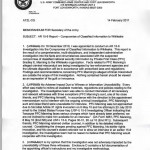
A report from February 2011 on the U.S. Army’s investigation into the compromise of classified information by Chelsea (Bradley) Manning.
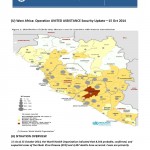
A collection of recent intelligence summaries for Operation United Assistance which is being conducted by U.S. Africa Command through U.S. Army Africa. The operation began in September and provides “coordination of logistics, training, and engineering support to the U.S. Agency for International Development (USAID) in West Africa to assist in the overall U.S. Government Foreign Humanitarian Assistance/Disaster Relief efforts to contain the spread of the Ebola Virus/Disease, as part of the international assistance effort supporting the Governments of Liberia, Sierra Leone and Guinea.”
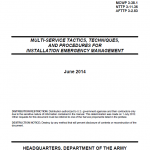
Multi-Service Tactics, Techniques, and Procedures for Installation Emergency represents a significant renaming and revision to the November 2007 publication Multiservice Tactics, Techniques, and Procedures for Installation CBRN Defense. It expands the scope from chemical, biological, radiological, and nuclear (CBRN) defense to all-hazards installation emergency management (IEM), including the management of CBRN events. This publication defines the roles of Department of Defense (DOD) installation commanders and staffs and provides the tactics, techniques, and procedures (TTP) associated with installation planning and preparedness for response to, and recovery from, hazards to save lives, protect property, and sustain mission readiness. The purpose of this publication is to summarize existing policies, responsibilities, and procedures for IEM programs at DOD installations worldwide for all hazards, as defined by DODI 6055.17, and to translate this policy into tactical terms applicable to military installation commanders.
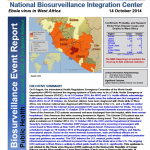
The most recent U.S. case, announced on 12 October 2014 is the first reported domestic transmission in the U.S. Three of the American EVD patients recovered and were discharged from the hospital, while three remain hospitalized. One American died while receiving treatment in Nigeria. The Liberian EVD patient was not symptomatic upon arrival and determined not to be infectious during travel. The Liberian patient died while in isolation on 8 October 2014. On 11 October 2014, the CDC and the Department of Homeland Security’s Customs & Border Protection (CBP) began enhanced entry screening of passengers with recent travel to West Africa at New York’s JFK International Airport. Enhanced entry screening is scheduled to begin on 16 October 2014 at Washington-Dulles, Newark, Chicago-O’Hare, and Atlanta international airports. Based on the recent domestic transmission, state and federal officials are re- examining whether equipment and procedures were properly followed, and whether additional protective steps and guidance are needed. The CDC believes the U.S. medical, public health infrastructure/responses are sufficient to prevent the spread of the Ebola virus in the U.S.
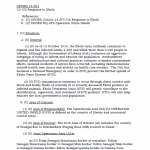
As of 15 October 2014, the Ebola virus outbreak continues to expand and has infected nearly 4,249 and killed more than 2,458 people in Liberia. Although the Government of Liberia (GoL) continues an aggressive campaign of trying to inform and educate the population, overburdened medical infrastructure and cultural practices continue to hinder containment efforts. Isolated incidents of unrest have occurred, including demonstrations outside health care clinics and attacks on health care workers. The GoL has declared a National Emergency in order to (IOT) prevent the further spread of Ebola Virus Disease (EVD).
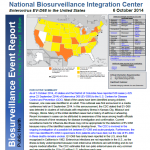
As of 3 October 2014, 43 states and the District of Columbia have reported 538 cases (+325 since 23 September 2014) of Enterovirus D68 (EV-D68) to the U.S. Centers for Disease Control and Prevention (CDC). Most of the cases have been identified among children; however, one case was identified in an adult. This outbreak was first announced in a media conference held on 8 September 2014. In this announcement, the CDC stated that EV-D68 was detected in clusters of individuals with respiratory illness in Kansas City, Missouri and Chicago, Illinois. Many of the initial identified cases had a history of asthma or wheezing. Recent increases in cases can be attributed to awareness of this issue among health officials and the amount of time necessary for disease investigation and confirmation. Current surveillance tools for influenza-like illness may not be appropriate for the detection of EV-D68 because many of the identified cases failed to develop fever. The CDC is involved in the ongoing investigation of a possible link between EV-D68 and acute paralysis. Furthermore, the CDC has identified EV-D68 in specimens from patients who have died, but the role of EV-D68 in these deaths remains unclear. EV-D68 has rarely been reported in the U.S. since first recognized in California in 1962. Enterovirus infections are not reportable in the U.S., so the illness is likely underreported because most enterovirus infections are self-limiting and do not require medical attention. The CDC estimates that non-polio enteroviruses are very common and are responsible for 10 to 15 million U.S. infections each year.
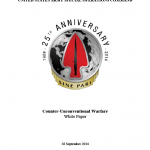
During the last decade, the U.S. military, along with its interagency and international partners, has generated significant capability to counter the irregular threats presented by non-state terrorists, insurgents, and criminal groups. During these same years, a distinct challenge to America and its partners in NATO and beyond has arisen through an innovative mix of such irregular threats. This challenge is Hybrid Warfare combining conventional, irregular, and asymmetric means, to include the persistent manipulation of political and ideological conflict. Foreshadowed by Iranian actions throughout the Middle East and by Chinese “unrestricted warfare” strategists in the 1990s, Hybrid Warfare has now reached its most brazen form in Russia’s support for separatist insurgents in Ukraine.
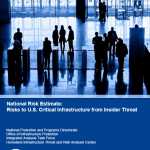
The Department of Homeland Security’s (DHS) Homeland Infrastructure Threat and Risk Analysis Center (HITRAC) produced this National Risk Estimate (NRE) to provide an authoritative, coordinated, risk-informed assessment of the key security issues faced by the Nation’s infrastructure protection community from malicious insiders. DHS used subject matter expert elicitations and tabletop exercises to project the effect of historic trends on risks over the next 3 to 5 years. In addition, DHS used alternative futures analysis to examine possible futures involving insider threats to critical infrastructure over the next 20 years. The results are intended to provide owners and operators a better understanding of the scope of the threat and can inform mitigation plans, policies, and programs, particularly those focused on high-impact attacks.

Body scanners are used to screen for contraband in a variety of places. Airports, schools, government buildings, and corrections facilities are examples of the types of places that have employed body scanners. Different types of body scanners have different capabilities based on the imaging technologies used and the sophistication of the internal system analysis. Metal detection was one of the first technologies developed to identify metallic objects on a person, but contraband can take many other forms, such as powders (e.g., drugs), paper (e.g., money), and even ceramic or plastic weapons. Correctional facilities in particular are faced with various forms of contraband, and with elaborate methods of evading detection employed by the local population. Manufacturers have responded by producing scanners that are able to detect nonmetallic contraband, as well as systems that can detect contraband inside body cavities. This report identifies commercially available body scanners and discusses the technologies used by these products. Technological limitations pertaining to the type of materials detected and/or the ability to detect contraband inside body cavities are discussed.

These policies are intended to provide law enforcement agencies uniform guidance regarding their appropriate use of a facial recognition field identification tool. Nlets sponsored the preparation of its Privacy Impact Assessment Report for the Utilization of Facial Recognition Technologies to Identify Subjects in the Field to better describe the privacy issues surrounding law enforcement agencies’ utilization of facial recognition technologies in the field. These policies were generated in response to the discussions contained in that report.
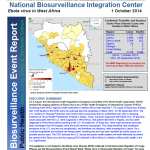
On 8 August, the International Health Regulations Emergency Committee of the World Health Organization (WHO) declared the ongoing epidemic of Ebola virus to be a Public Health Emergency of International Concern (PHEIC). According to the WHO, regional health authorities in western Africa have reported 7,178 cases of Ebola virus disease with 3,338 deaths to the WHO since the outbreak was first recognized in March 2014. On 30 September 2014, The U.S. Centers for Disease Prevention and Control (CDC) announced that an unidentified man, who is receiving treatment at Texas Health Presbyterian Hospital in Dallas, Texas, has been diagnosed with Ebola virus. All previous cases associated with the U.S. were diagnosed in West Africa. One patient died while in Nigeria, and four were diagnosed in West Africa before traveling to the U.S. for treatment.
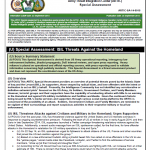
This ARTIC Special Assessment provides an overview of potential threats posed by the Islamic State of Iraq and the Levant (ISIL), its supporters, those swayed by radical Islam, and lone offenders with the intent or inclination to act on ISIL’s behalf. Presently, the Intelligence Community has not identified any corroborative or definitive extremist plots focused on the US Army, its Soldiers, Government Civilians, and Family Members. However, terrorist groups and their supporters have the capability of conducting attacks with little to no warning in the Homeland and against US military installations and facilities worldwide. Given the continued rhetoric being issued by ISIL’s media services and supporters through various social media platforms the ARTIC is concerned of the possibility of an attack. Soldiers, Government Civilians and Family Members are reminded to be vigilant of their surroundings and report suspicious activities to their respective military or local law enforcement.
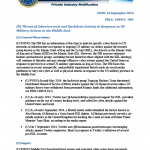
The FBI has no information at this time to indicate specific cyber threats to US networks or infrastructure in response to ongoing US military air strikes against the terrorist group known as the Islamic State of Iraq and the Levant (ISIL), also known as the Islamic State of Iraq and al-Shams (ISIS) or the Islamic State (IS). However, the FBI assesses extremist hackers and hacktivist groups, including but not limited to those aligned with the ISIL ideology, will continue to threaten and may attempt offensive cyber actions against the United States in response to perceived or actual US military operations in Iraq or Syria. The FBI bases this assessment on recent, nonspecific, and probably aspirational threats made on social media platforms to carry out cyber as well as physical attacks in response to the US military presence in the Middle East.
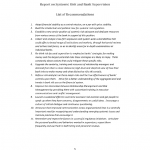
The 2007-2009 financial crisis was a systemic collapse – a sudden collapse of asset prices and the failure or near-failure/rescue of almost all large financial institutions. The United States has not witnessed a systemic collapse since the 1930s, and many thought it was impossible for the United States to have such an event, given the apparent advances in risk management that preceded it. However, the collapse occurred and was very large, damaging to the real economy and extremely expensive to resolve. A desire not to let such an event happen again pervades the body politic, indeed is demanded by many. But preventing such an event is neither easy nor costless. Financial crises typically follow large economic booms. While such booms may be characterized as bubbles in retrospect, they are extremely popular while they are occurring. The Federal Reserve has long seen its mission against inflation “to take away the punch bowl just when the party is getting good”; if it now becomes the systemic risk regulator it must be prepared to do the same against rising systemic risk, using tools beyond monetary policy. This is likely to be unpopular unless the ground is extremely well prepared and broadly understood. We return to this threshold problem in more detail below.
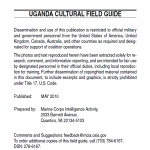
The Uganda Cultural Field Guide is designed to provide deploying military personnel an overview of Uganda’s cultural terrain. In this field guide, Uganda’s cultural history has been synopsized to capture the more significant aspects of the country’s cultural environment, with emphasis on factors having the greatest potential to impact operations.
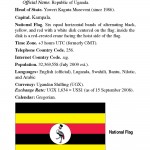
This handbook provides basic reference information on Uganda, including its geography, history, government, military forces, and communications and transportation networks. This information is intended to familiarize military personnel with local customs and area knowledge to assist them during their assignment to Uganda.
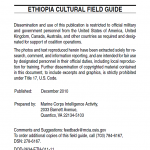
The Ethiopia Cultural Field Guide is designed to provide deploying military personnel an overview of Ethiopia’s cultural terrain. In this field guide, Ethiopia’s cultural history has been synopsized to capture the more significant aspects of the country’s cultural environment, with emphasis on factors having the greatest potential to impact operations.
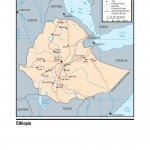
This handbook provides basic reference information on Ethiopia, including its geography, history, government, military forces, and communications and transportation networks. This information is intended to familiarize military personnel with local customs and area knowledge to assist them during their assignment to Ethiopia.
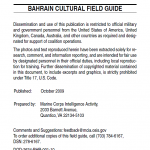
The Bahrain Cultural Field Guide is designed to provide deploying military personnel an overview of Bahrain’s cultural terrain. In this field guide, Bahrain’s cultural history has been synopsized to capture the more significant aspects of the country’s cultural environment, with emphasis on factors having the greatest potential to impact operations.